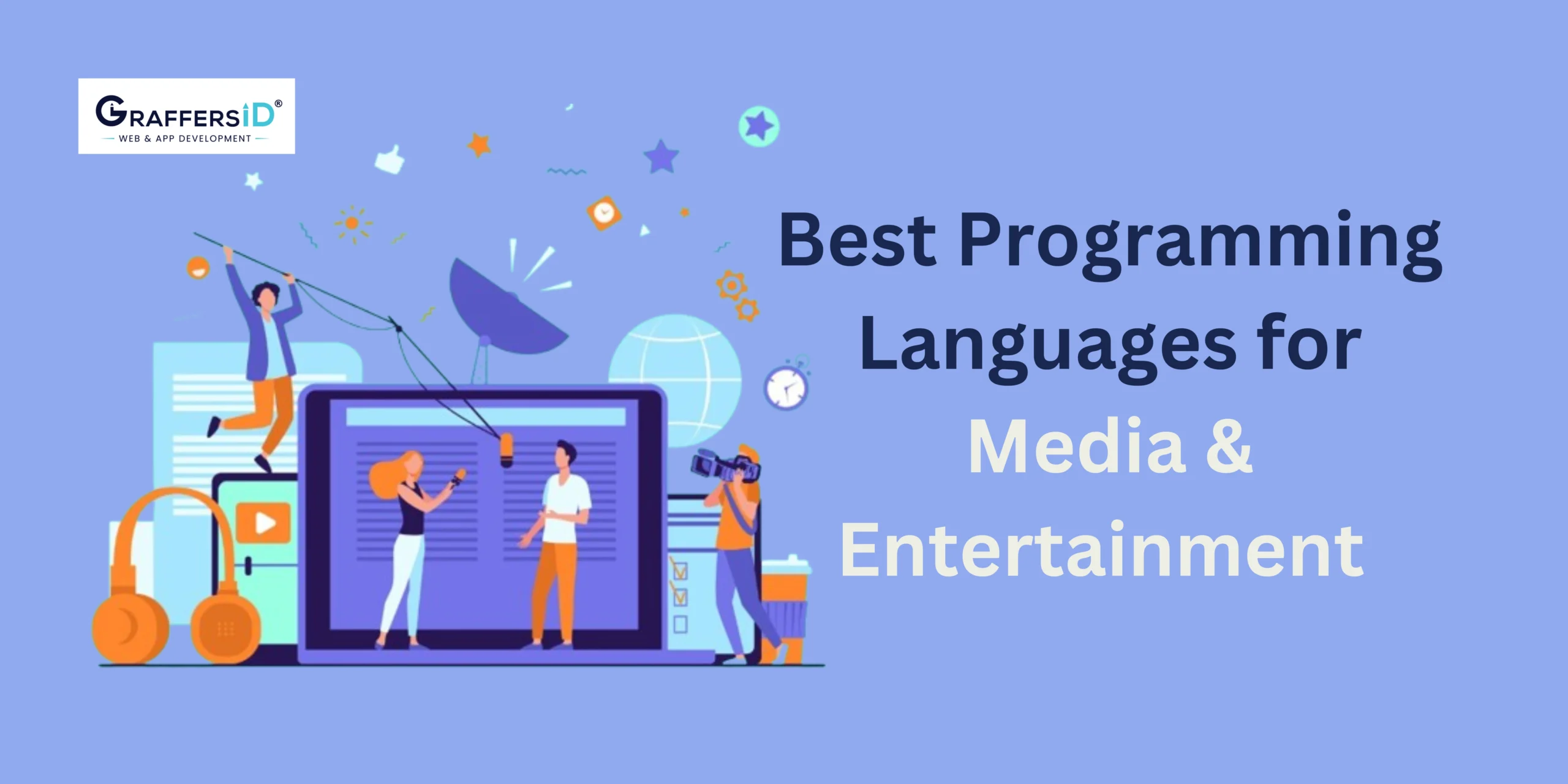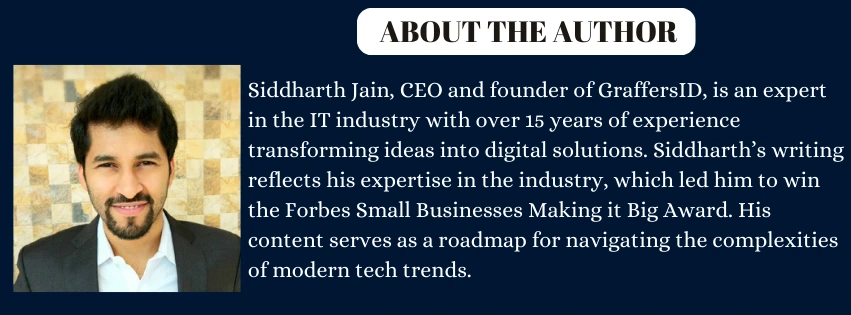The media and entertainment industries are quickly changing as a result of developments in artificial intelligence (AI), immersive technologies, and real-time content streaming. As digital media consumption increases, so does the demand for high-performance apps and software. When developing OTT platforms, video editing tools, gaming applications, or AI-driven content recommendation systems, selecting the correct programming language is important for ensuring smooth functioning, scalability, and user engagement. In this blog, we will examine the top seven programming languages for media and entertainment app/software development in 2025, along with their features, frameworks, and practical applications.
Importance of Selecting the Right Programming Language for Media and Entertainment
Developing applications for the media and entertainment sector involves a programming language that can support high-performance computing, real-time content delivery, AI-based automation, and security issues. The proper choice impacts:
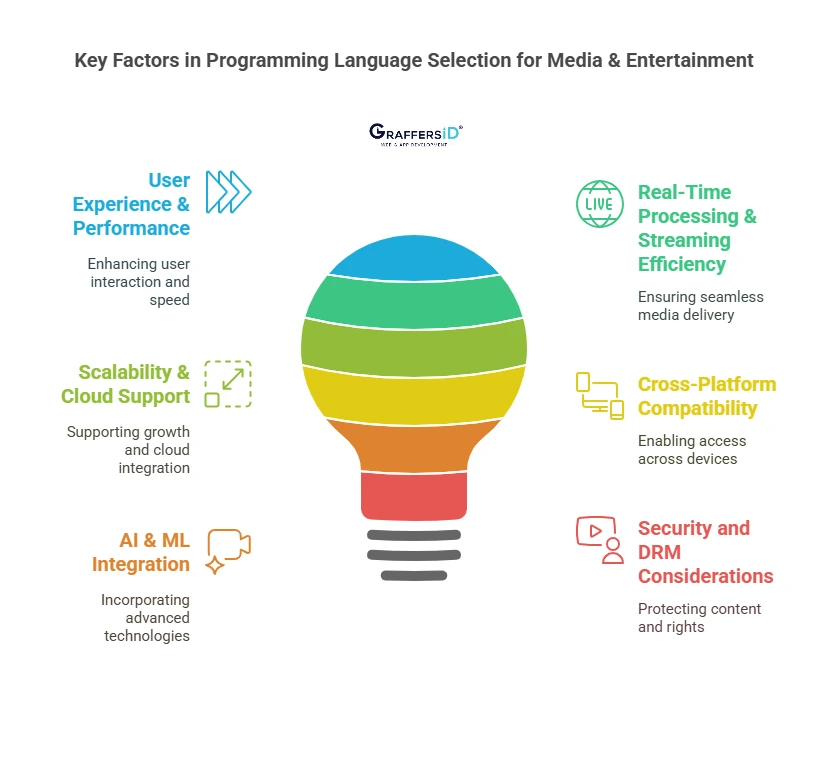
1. User Experience & Performance
- The responsiveness and speed of an application have a major impact on user engagement and retention.
- Efficient programming languages ensure that media content plays smoothly, has minimum latency, and is processed smoothly.
2. Real-Time Processing and Streaming Efficiency
- Video streaming services, gaming apps, and live content all require high-speed, real-time processing.
- Efficient memory management and concurrency control provide smooth media transmission without buffering or lag.
3. Scalability and Cloud Support
- With millions of people simultaneously accessing media sites, the programming language must be scalable and cloud-native.
- Compatibility with cloud service providers like AWS, Google Cloud, and Azure enables simple global content distribution.
4. Cross-Platform Compatibility (Smart TVs, VR, AR, Web, Mobile)
- Media applications must be compatible with many platforms, including the web, mobile, smart TVs, gaming consoles, and AR/VR devices.
- The proper programming language enables effective front-end and back-end development, ensuring a smooth user experience on all devices.
5. AI & ML Integration for Content Recommendation and Automation
- AI-powered content recommendation, automated video editing, and deep learning models are all based on computer languages that support AI/ML frameworks.
- Applications like Netflix’s recommendation engine and AI-generated video editing tools are built with machine learning-optimized languages.
6. Security and DRM (Digital Rights Management) Considerations
- Media businesses are very concerned about protecting copyrighted information from piracy.
- A programming language should provide strong encryption, watermarking, and DRM frameworks to prevent unauthorized access and distribution.
Top 7 Programming Languages for Media and Entertainment App/Software Development in 2025
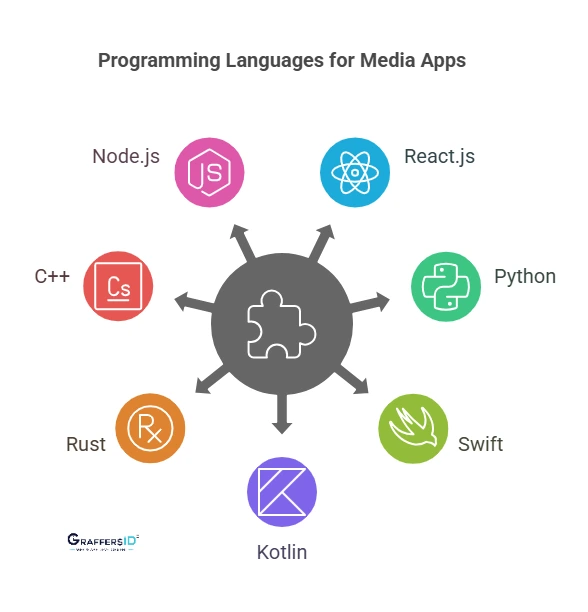
1. React.js: Best for Web-based Media and Streaming Platforms
React.js enables you to build dynamic, high-performance, and interactive user interfaces, which are important for modern media applications that need smooth transitions and real-time content updates. The Virtual DOM simplifies rendering by updating only changing components instead of reloading the entire page, resulting in faster UI performance and a better user experience.
Framework
- Next.js enhances React.js with server-side rendering (SSR) and static site generation (SSG), which improves SEO and initial load performance for content-heavy sites.
- Three.js is a JavaScript library for creating 3D animations and interactive media in web applications.
- React Native allows cross-platform mobile programming, allowing media applications to function smoothly on both iOS and Android.
- Redux is a state management solution that helps in the managing of complicated application states, making it suitable for large-scale applications that require dynamic content updates.
- Gatsby.js is a static site generator designed to create fast, content-driven media websites that include built-in image optimization and GraphQL support.
Use Cases
- Netflix UI, YouTube, and Spotify Web use React.js to provide a fast, responsive, and immersive user experience.
- Interactive video streaming applications use React.js to provide smooth video playback, real-time comments, and social engagement features.
- React.js is used by news portals and digital magazines to design compelling interfaces with fast-loading and interactive content.
Want to create an interactive, dynamic, and scalable media application? GraffersID provides remote React.js developers to create immersive user experiences and smooth video streaming platforms.
2. Python: AI & Data-Driven Media Applications
Python‘s wide libraries and frameworks make it an ideal platform for AI-powered media and entertainment applications. The language is commonly used to create recommendation engines, AI-generated content, and automated video processing. Its adaptability and ease of integration with AI models allow for smooth deployment in industrial settings.
Frameworks
- TensorFlow and Keras are advanced deep learning frameworks used for AI-powered media applications, including personalized content suggestions and facial recognition.
- OpenCV is an image and video processing toolkit commonly used for object detection, facial recognition, and motion tracking in video applications.
- Flask and Django are web frameworks that allow backend development for scalable media applications, such as AI-driven streaming services.
- MoviePy is a Python library for programmatic video processing and editing, ideal for the automated creation of media content.
- Pandas and NumPy are needed for data processing and analysis, which enhance content recommendations and audience insights.
Use Cases
- Python is used by Netflix and Spotify’s recommendation systems to provide personalized content suggestions.
- Automated video editing and AI-generated content applications, such as deepfake creation and video summarizing.
- Media security and automated video content tagging use facial recognition and object detection.
3. Swift: Ideal for iOS Media Apps and Apple Ecosystem
Swift is made for Apple’s ecosystem, with optimized performance and compatibility with iOS, macOS, and other Apple products. Secure and efficient memory management minimizes crashes and enhances media playback. Smooth video and audio playback are offered through native high-performance media applications.
Frameworks
- AVFoundation and CoreMedia are used for high-performance media playback, real-time audio/video processing, and DRM-protected content streaming.
- RealityKit and ARKit are essential for developing augmented reality (AR) applications for immersive media experiences.
- SpriteKit and SceneKit frameworks for 2D and 3D game development within the Apple ecosystem, supporting high-quality graphics and animations.
- Combin is a framework for handling asynchronous and event-driven programming, useful for media applications with real-time content updates.
Use Cases
- Apple Music, Final Cut Pro, and iOS streaming apps are developed with Swift for native compatibility and high performance.
- Augmented reality-based media apps use ARKit to provide smooth experiences in interactive content and gaming.
- iOS video editing apps take advantage of Swift’s efficient processing for fast rendering and real-time effects.
4. Kotlin: Leading Choice for Android Media Applications
Kotlin is the official language for Android development, offering a modern syntax and improved runtime performance over Java. It increases productivity for developers with shorter syntax and less boilerplate code. Better memory management and performance make it perfect for resource-consuming media apps.
Frameworks
- Jetpack Compose is a modern UI toolkit for creating interactive and fluid user interfaces in Android media applications.
- ExoPlayer is a customizable video player supporting adaptive streaming, DRM, and high-resolution playback.
- Ktor is a synchronous and lightweight backend service framework suitable for media apps that need real-time data processing.
- CameraX is a framework to extend camera capabilities to media creation apps like live streaming and video recording.
Use Cases
- Hotstar, Prime Video, and other streaming apps based on Android use Kotlin for smooth video playback and UI performance.
- Android video and music editing applications utilize Kotlin for efficient, high-speed media processing and real-time effects.
- Media-sharing social media sites use Kotlin’s advanced backend features to provide smooth content delivery and user interaction.
5. Rust: High-Performance, Secure Media Processing
Rust allows memory safety without garbage collection, delivering high performance for real-time media processing. Its low-level control allows it to execute latency-sensitive applications, such as video streaming and game engines, efficiently.
Frameworks
- Bevy, Tokio, and Actix are used to create high-performance media applications using parallel processing and concurrency.
- GStreamer is a framework for processing audio and video in real time and streaming multimedia.
- FFmpeg is a powerful library for encoding, decoding, and editing audio and video.
Use Cases
- Game engines, real-time video streaming, and VR/AR development all require Rust’s performance advantages.
- Secure DRM (Digital Rights Management) implementations use Rust’s memory safety and encryption features.
- Rust’s efficient execution is useful for high-performance media compression and rendering engines.
6. C++: Game Development & High-Performance Media Processing
C++ gives direct hardware access, allowing for high-performance video rendering and media processing. It’s commonly used in game development and real-time simulation applications.
Frameworks
- Unreal Engine, Unity (with C# support), and OpenCV are important for game development, real-time video processing, and computer vision applications.
Use Cases
- AAA game production uses C++ for high-performance graphics rendering.
- C++ is used in video editing software to enable fast rendering and real-time media manipulation.
- Video processing apps use advanced media encoding and decoding methods.
7. Node.js: Scalable Backend for Media Streaming Services
Node.js has an event-driven, non-blocking architecture, which makes it perfect for real-time media applications. It provides scalable backend services to manage large numbers of simultaneous users and data streaming.
Frameworks
- Express.js, Nest.js, and Socket.io are used for live interactions, scalable APIs, and real-time streaming.
Use Cases
- Twitch and other live broadcasting systems use Node.js to provide smooth real-time communication.
- The backend technology of OTT platforms ensures fast and scalable content delivery.
- Node.js is used by media asset management and CDNs to handle large-scale media distribution.
Need a powerful backend for real-time video streaming and media processing? GraffersID offers expert Node.js developers who can create highly scalable and secure media applications.
Comparing the 7 Best Programming Languages for Media & Entertainment Development
| Language | Best For | Key Strengths | Notable Use Cases |
| React.js | Web-based media apps | UI interactivity, real-time updates | Netflix UI, YouTube |
| Python | AI-powered media solutions | AI libraries, fast prototyping | Content recommendation, AI-generated media |
| Swift | iOS media apps | High performance, Apple ecosystem | Apple Music, iMovie |
| Kotlin | Modern, concise, robust | Modern, concise, robust | Hotstar, Prime Video |
| Rust | High-performance & secure media apps | Memory safety, speed | VR/AR, real-time streaming |
| C++ | Game engines & high-end processing | Performance, gaming frameworks | Unreal Engine, OpenCV |
| Node.js | Scalable backend media solutions | Non-blocking, real-time processing | Twitch, live streaming backends |
Read More: Create Streaming App Like Netflix: An Ultimate Guide
Future Trends in Media & Entertainment Software Development
As technology advances, some important factors are expected to affect the future of media and entertainment software development:
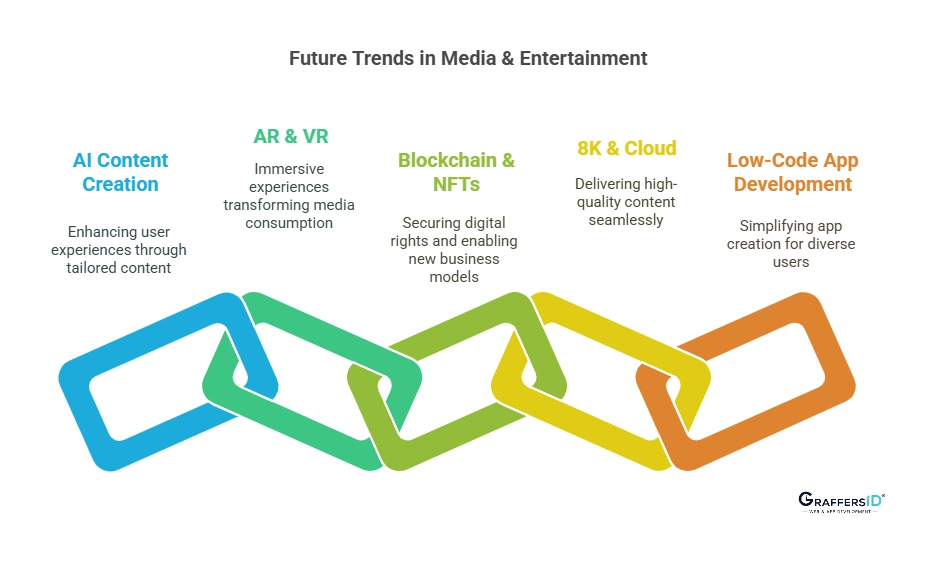
1. AI-powered Content Creation and Personalization
- AI-powered tools are automating video editing, voice synthesis, and scriptwriting, changing content creation.
- Machine learning algorithms improve tailored suggestions, which increases user engagement on sites such as Netflix, YouTube, and Spotify.
- AI-generated content, such as music creation and deepfake video editing, is becoming more popular.
2. Augmented and Virtual Reality
- AR and VR technologies are developing realistic experiences for gaming, live concerts, and virtual movie screenings.
- AR is being used on social media platforms to enhance interactive storytelling and digital advertising.
- The metaverse is creating more options for virtual entertainment centers and digital events.
3. Blockchain and NFTs in Media
- Blockchain technology ensures secure transactions and decentralized content delivery, which reduces piracy threats.
- Non-fungible tokens (NFTs) enable digital ownership of unique media assets ranging from music songs to movie treasures.
- Smart contracts allow royalty distribution, ensuring that artists and producers are fairly compensated.
4. 8K Streaming and Cloud-based Media Solutions
- With the growing demand for ultra-high-definition (UHD) streaming, content providers are investing in 8K video capability.
- Cloud streaming technologies allow for low-latency playback and worldwide content distribution.
- AI-enhanced video upscaling improves the quality of lower-resolution content.
5. Low-Code and No-Code Media App Development
- The rise of low-code and no-code platforms allows non-developers to create interactive media apps.
- These platforms reduce development times and costs, making media technology more accessible to entrepreneurs and individual creators.
- No-code video editing and automation solutions allow for faster content development and delivery.
Conclusion
Choosing the correct programming language is important when creating high-performance media and entertainment apps. Whether you’re developing an AI-powered content recommendation system, a live-streaming OTT platform, a gaming engine, or an interactive media app, the language you choose must provide scalability, speed, security, and an easy interface with modern technologies.
By using the right programming tools, developers can create realistic and engaging media experiences that meet the changing demands of users in 2025. To create advanced, future-ready media apps, it is important to stay ahead of market trends and new technological developments.
Looking to create a high-performing media application? GraffersID offers skilled remote developers with expertise in developing media and entertainment applications. Hire expert developers today to boost your project’s success! Contact us today!
FAQs
Q1 Which programming language is used in Netflix?
Netflix uses Java and Scala for the backend, Python for AI suggestions, Node.js for scalable backend, and React.js for frontend UI.
Q2 Which programming language is used in Amazon?
Amazon (Prime Video) uses Java and Kotlin for Android, Swift for iOS, Python for AI, Node.js for the backend, and C++ for video processing.
Q3 Which programming language is best for video streaming?
React.js (UI), Node.js (backend), Python (AI), C++ & Rust (processing), and Swift/Kotlin (mobile) are all good options for video streaming.
Q4 Which programming language is best for developing a media streaming platform?
React.js is most suited for front-end UI development, whereas Node.js works best for backend scalability in media streaming applications. Python is commonly used in AI-driven content recommendations.
Q5 What are the key factors to consider when choosing a programming language for media applications?
Performance, scalability, real-time processing features, cross-platform compatibility, AI and ML support, and security (particularly for DRM protection) are important.
